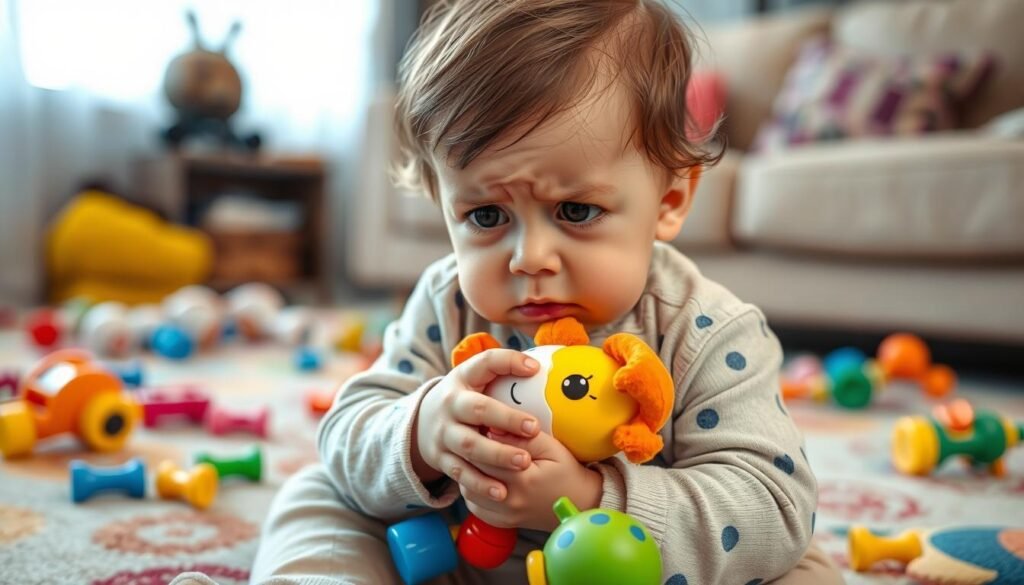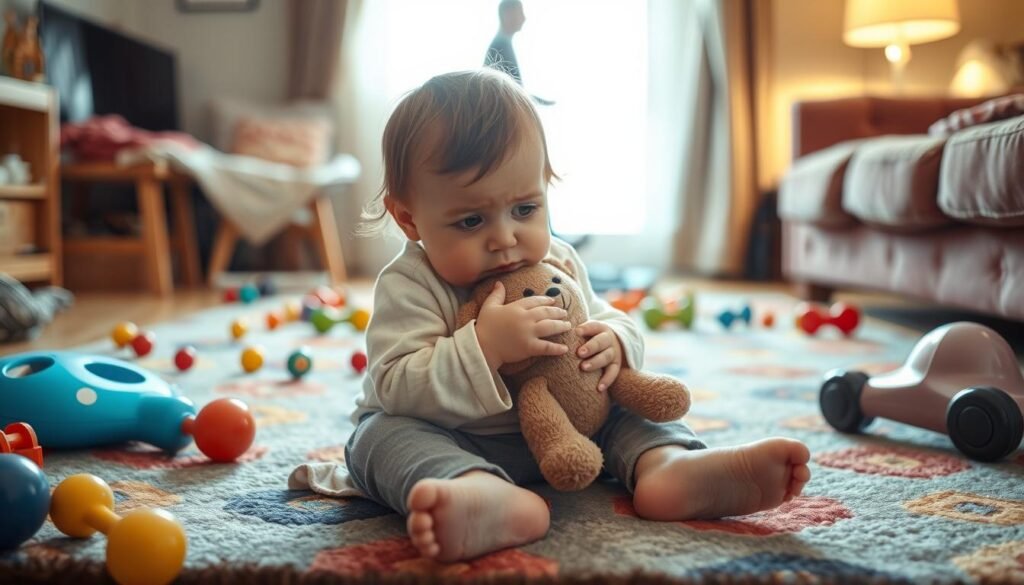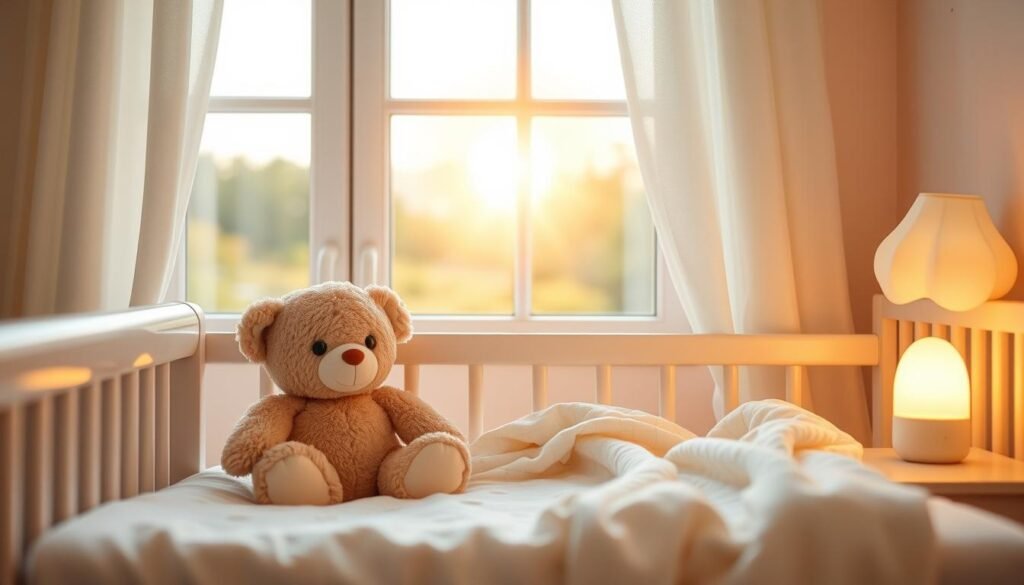About 80% of toddlers feel separation anxiety from 12 to 18 months old. This phase is part of their growth. It shows they need support as they start to be more independent. For parents dealing with a 2-year-old’s separation anxiety, knowing why it happens and how to manage it can help. It turns tough times into chances for growth.
This article gives parents tips on handling separation anxiety. It helps you spot the signs and what causes it. Learning how to support your toddler’s independence while keeping a close bond is key.
Key Takeaways
- Separation anxiety often begins around 8 months and peaks between 12 to 18 months.
- Most toddlers show signs of separation anxiety by age 2.
- Consistency in routines can greatly reduce anxiety levels.
- Consult a pediatrician if anxiety persists beyond preschool.
- Knowing what upsets your toddler is key to managing their anxiety.
Understanding Separation Anxiety in Toddlers
Separation anxiety in toddlers is part of growing up. It’s when kids start to be more independent. This phase usually begins between 6 to 12 months and may last until they’re about 3 years old. During this time, they might act out when they’re not with their caregivers.
It’s important to know why toddlers feel this way. It helps parents care for their little ones better. As children understand that things and people are still there, even if they can’t see them, they might feel uneasy when apart from loved ones.
Usually, separation anxiety is normal. But, certain behaviors in 2-year-olds could be worrying if they don’t go away. Refusing to let go or throwing fits when being dropped off might mean their anxiety is stronger. This could make it hard for them to adjust to places like preschool.
“Managing separation anxiety requires keeping goodbyes brief and providing routine adjustments to create a predictable environment for the child.”
Parents should watch how their child acts and get help if these feelings don’t improve after they turn 3. Understanding separation anxiety helps parents support their kids during this tough but common stage of growth.
Signs of Separation Anxiety in 2-Year-Olds
2-year-olds show signs of separation anxiety in different ways as they understand their world. Look for signs like:
- Clinginess to their primary caregiver.
- Intense tantrums when faced with separation.
- Resistance to being left in unfamiliar places, like daycare or a relative’s home.
- Visible distress such as crying or expressing fear when separated.
Dr. Fran Walfish says these behaviors are normal for children understanding their surroundings. As they learn about social situations, toddlers need to know their caregiver will come back. This is especially true during key changes, such as daycare drop-offs or bedtime.
Almost every child from 18 months to 3 years experiences clinginess. Observing these behaviors in 2-year-olds helps parents deal with separation anxiety in toddlers. It’s important to recognize these signs early. This way, parents can help their child’s emotional growth and make them feel safe.

| Behavior | Description |
|---|---|
| Clinginess | The child stays close to the caregiver, often following them around. |
| Tantrums | Outbursts of anger or frustration related to being apart from the caregiver. |
| Fear in New Environments | Demonstrates signs of distress when introduced to new places or people. |
| Distress During Transitions | Vocal displays of fear or anxiety during times of separation such as when dropped off at daycare. |
Causes of Separation Anxiety in Toddlers Age 2
Separation anxiety in toddlers age 2 comes from many factors. These factors impact their feelings as they understand more about the world. They start noticing when someone isn’t there which can make them anxious. Changes like starting daycare or a new sibling arriving can make things feel unstable.
The causes of separation anxiety in toddlers can also relate to family issues, such as fights or divorce. Kids this age learn that people they love still exist even if they can’t see them. Not knowing when they’ll see someone can stress them out.
How recent events have gone can also affect a child. Toddlers who’ve been away from their main caregivers for a while may get more anxious about being apart later. The way parents treat their child’s need for independence matters too. Being too controlling can make a child more clingy and worried.
Although most kids move past this stage on their own, understanding the causes of separation anxiety in toddlers age 2 helps parents support them better. If this anxiety is very strong or messes with daily life, seeing a doctor or therapist is key. They can offer help and advice.
Common Triggers of Separation Anxiety
Separation anxiety comes from different things that make a child feel upset. It’s important to know what these things are to help little ones deal with their feelings. Some issues that can make kids worry include saying goodbye, being in crowded places, bedtime, and trying new things. Each moment, like when they have to leave someone, can be hard for them. They often need to know that the people they love will come back. This helps them feel better.
At night, being away from their main caregiver can make kids feel more anxious. This is because they feel alone for longer. Kids who are 2 to 3 years old might still feel really worried about being away from someone they love. Being around new people or in places with lots of activity can scare them and make them want to stay very close to someone they trust. That’s why it’s important for moms and dads to watch how their child acts in different places.
Knowing what makes kids feel anxious is a big step in helping them. When parents understand the specific things that upset their child, they can do things to help them feel less scared. This goes a long way in helping kids grow up feeling emotionally strong. Below is a list of common things that make kids anxious, how these things affect them, and what parents can do to help:
| Trigger | Impact on Toddler | Management Strategy |
|---|---|---|
| Farewells | Heightened anxiety and clinginess | Practice brief goodbyes to normalize separation |
| Large Gatherings | Fear due to unfamiliar faces | Prepare the child in advance; choose familiar settings |
| Nighttime Routines | Increased separation anxiety | Establish a calming bedtime routine with reassurance |
| New Experiences | Feelings of insecurity and fear | Introduce new situations gradually and provide support |
Separation Anxiety Symptoms in 2-Year-Olds
Separation anxiety in 2-year-old toddlers shows up in many ways. It often leaves both kids and parents feeling upset. Signs include a lot of crying, tantrums when being apart, and not wanting strangers to hold them. Toddlers might also feel restless. They sometimes have stomachaches or headaches because they’re anxious. Understanding these signs helps parents know how to react.
At about 8 months, toddlers start to show these signs. It’s a natural part of growing up. By 2 years old, nearly all kids feel some anxiety when away from their parents. But, if a child’s fear of being apart is extreme, it might be Separation Anxiety Disorder (SAD). Kids with SAD may not want to let go of a family member. They fear losing them or panic when not together. This can really affect their daily activities.
Having SAD can make simple things hard for toddlers. They might find it tough to focus in preschool. They often have bad dreams about being apart from their loved ones. Knowing the signs of separation anxiety in toddlers age 2 is the first step. It helps parents decide if they need to find advice or help.
| Symptom | Indication |
|---|---|
| Excessive Crying | Distress when separated from caregivers |
| Tantrums | Difficulty coping with separations |
| Clinginess | Fear of being without loved ones |
| Physical Symptoms | Stomachaches, headaches related to anxiety |
| Disturbances in Sleep | Refusal to sleep alone or nightmares about separation |
| Worrying | Constant anxiety about losing a family member |

Separation Anxiety in Toddlers Age 2: Coping Strategies
As toddlers near age two, helping them handle separation anxiety is key for both kids and parents. Good strategies make this easier for toddlers who feel anxious when apart from their parents. These tips aim to make kids feel secure and grow their independence.
Establishing a Goodbye Ritual
Having a consistent goodbye ritual can really help ease separation anxiety. Parents can pick a short, loving goodbye to help their child feel better. This routine lets toddlers know what’s coming, helping them feel less worried. A simple gesture, like a unique handshake or a hug, gives them comfort.
Creating a Consistent Routine
A steady routine each day helps build trust and makes things predictable for children. In a world they can predict, children do better. Making sure meals, naps, and playtime are at the same times every day helps toddlers feel safe. This is very important for children dealing with separation anxiety.
Practicing Short Separations
Starting with short times apart can help toddlers get used to being without their caregiver. Begin with quick moments away and then slowly, the time apart can be longer. This helps children build independence and confidence, making longer separations easier to handle.

| Strategy | Description | Benefits |
|---|---|---|
| Goodbye Ritual | A brief, affectionate farewell. | Reduces uncertainty and provides comfort. |
| Consistent Routine | Establishing regular daily activities. | Creates a predictable environment that fosters security. |
| Short Separations | Practicing brief absences before longer ones. | Builds confidence and independence in the child. |
Reducing Separation Anxiety in Toddlers
Reducing separation anxiety in toddlers means setting up a warm and supportive vibe. It’s important to talk openly. Let them know when you’ll come back. This helps them get a feel for time and builds trust. Having other caregivers keep up with daily routines also helps. It makes the child feel safe.
Keeping toddlers busy when you’re apart works wonders. Have caregivers do favorite things with them, like reading or playing. Setting up fun tasks for your child can distract them. It shows them that being apart won’t last forever.
- Establish a reassuring goodbye ritual, such as a special wave or kiss.
- Encourage toddlers to carry a lovey or comfort item, providing additional security.
- Be brief and positive when leaving, avoiding lengthy goodbyes that might amplify anxiety.
Big changes, like starting daycare, can spike a toddler’s separation anxiety. Practice being apart before these events to ease their stress. Getting to know new caregivers slowly helps too. It cuts down on their fear and makes them comfortable.
Always be honest but positive when talking about upcoming separations. Start these chats a few days before any big change. This gets your child ready and involved. It’s a key way to help them handle their anxiety better.
If your toddler’s anxiety stops them from sleeping or doing daily things, see a doctor. Watch for signs like constant worry or physical issues. A professional can give you advice to improve your child’s emotional well-being.
Support and Resources for Parents
Managing toddler separation anxiety can be tough for parents. There are resources available to help with toddler separation anxiety. These ensure the child and caregiver handle this phase well. Books on parenting, focusing on coping methods, can be really useful. “Owl Babies” is one such book that shows what kids feel when they’re apart from their parents.
Support groups offer a space to share experiences and solutions. Talking with other parents can make you feel less alone. It can also give new ways to deal with separation anxiety. You can find these groups in community centers or online.
Pediatricians are key in offering expert advice. If a toddler’s anxiety is intense or hard to handle, they can help. Regular visits ensure that any concerning behavior is looked after.
Setting specific routines for new situations like school helps a lot. Some strategies are:
- Establishing a unique goodbye ritual, such as a playful handshake.
- Playing hide and seek to learn about being apart and coming back together.
- Using visual aids, like charts, to show what the day will look like.
- Playing pretend games about saying goodbye and reuniting.
It’s vital for parents to listen to their toddlers. Letting them talk about their feelings builds trust. Encouraging them to make friends can also provide emotional support.
Creating a soothing environment reduces separation anxiety, ensuring the child feels safe and loved. With the right resources and strategies, parents can help their children overcome separation anxiety with confidence.
| Resource Type | Description | Example |
|---|---|---|
| Books | Literature that addresses separation anxiety. | “Owl Babies” |
| Support Groups | Communities for parents to share experiences. | Local parenting meetups |
| Pediatric Help | Medical guidance for ongoing issues. | Consultation for severe anxiety |
| Visual Aids | Tools to help children anticipate separation. | Daily routines chart |
Conclusion
Separation anxiety in toddlers aged 2 is a common phase parents face. It’s normal for kids to show this behavior as they grow. Studies show that 63% of toddlers have little to no separation anxiety. But, a small number experience it more intensely, showing kids react differently to being apart.
How parents handle separation anxiety matters a lot. Parenting styles that are either too controlling or too harsh can affect a child’s anxiety. Parents can help by keeping a regular routine, saying goodbye in special ways, and talking openly with their kids.
To help toddlers with separation anxiety, parents should pay attention to their needs but also help them become more independent. Knowing what causes their anxiety and how parents’ actions affect them is key. This helps strengthen the connection between parent and child, leading to trust and resilience for both.